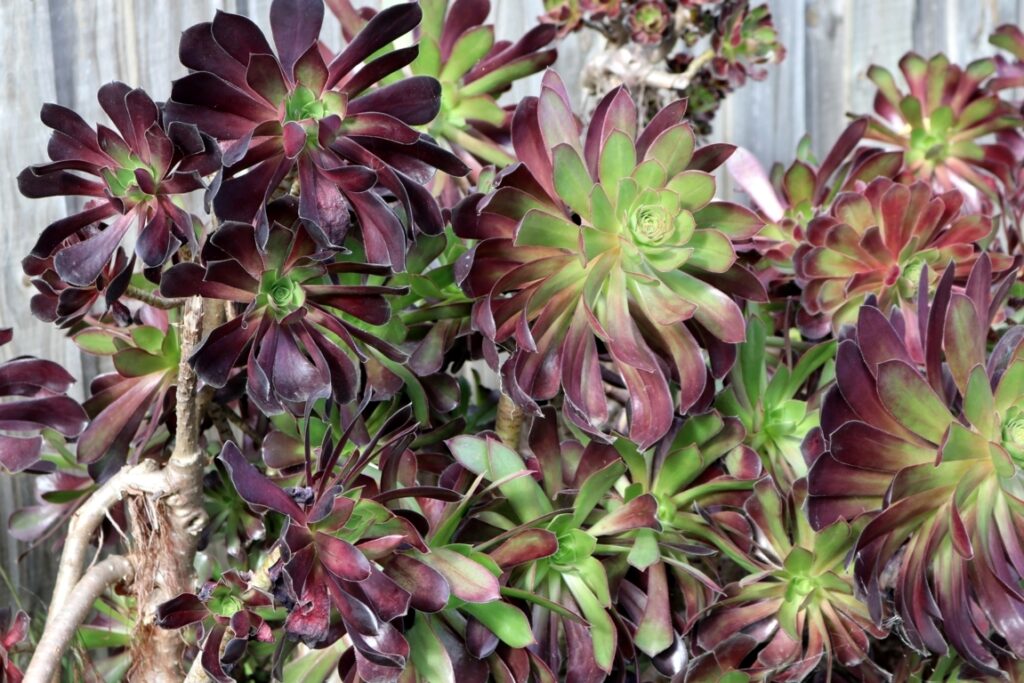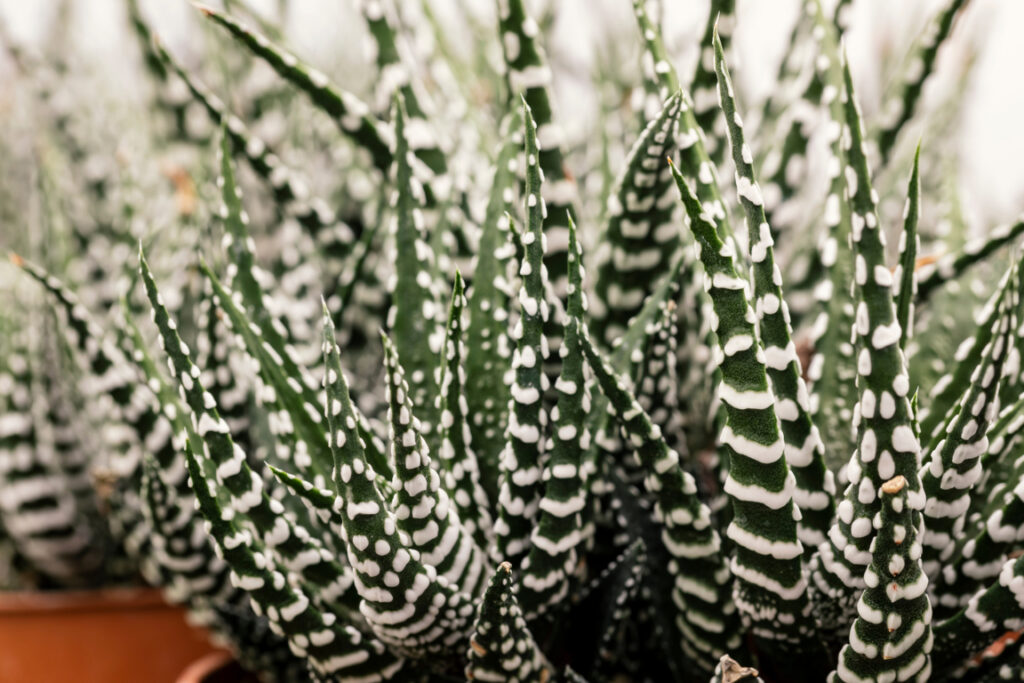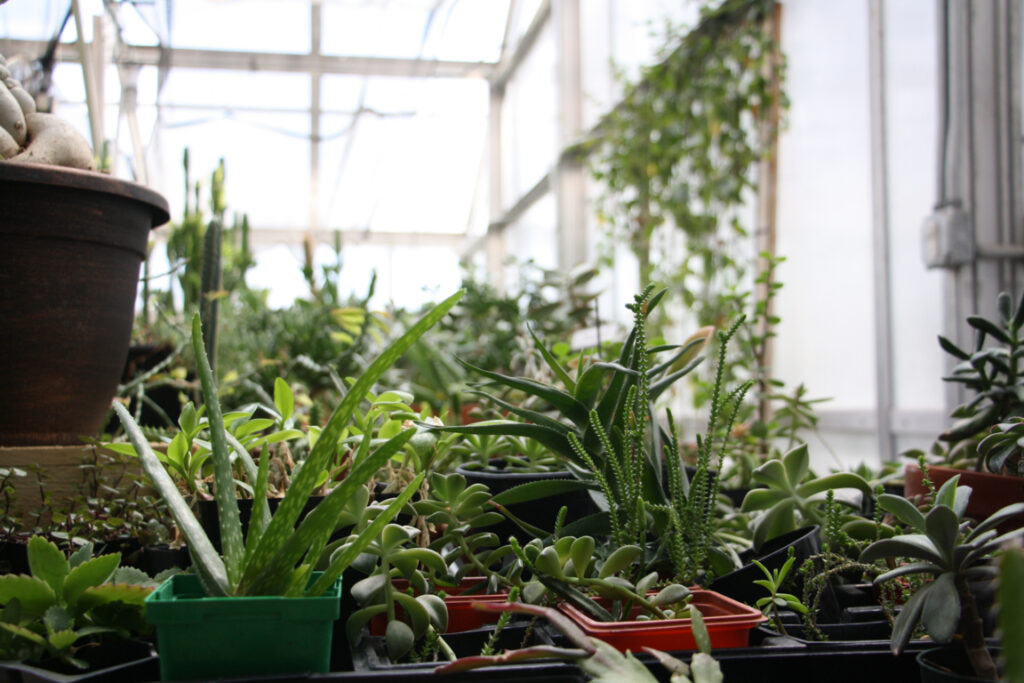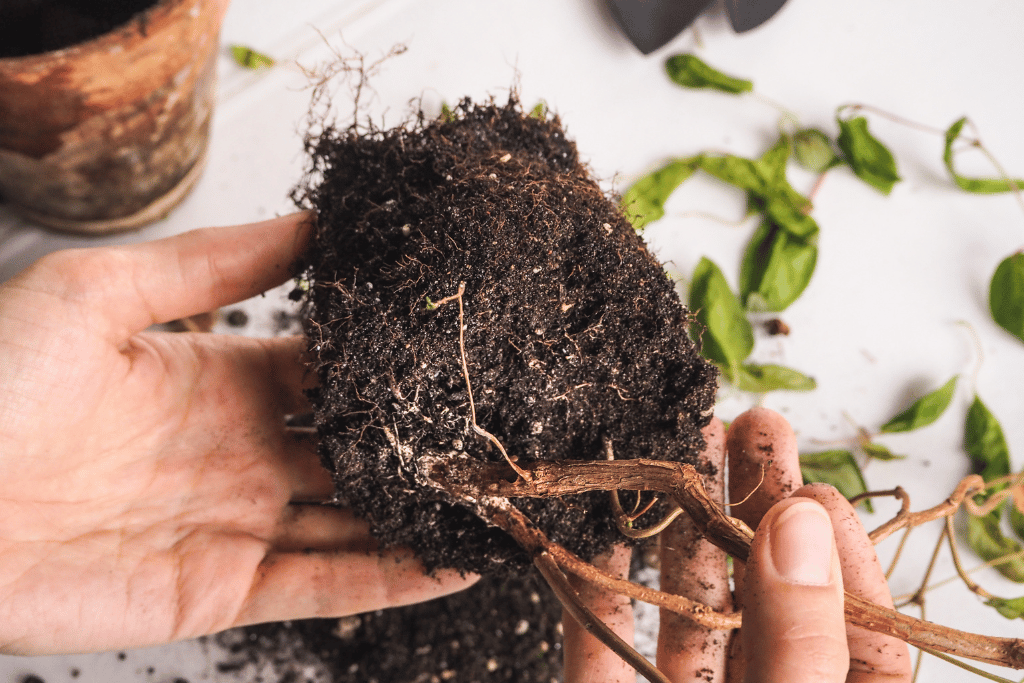
Imagine tall, vibrant succulent plants spiking up and bringing a new level of life to your garden! Wouldn’t you want tall succulent types to be the star of your landscape? Succulents come in a vast range of shapes and sizes, and tall types are perfect for adding height and texture to any garden.
There is an incredible variety of tall succulent types available, and this guide will help you learn all about them! We’ll explore different varieties of tall succulents, and how to care for tall succulent plants.
Keep reading if you’re looking for some tall varieties of succulents that will bring your garden to life!
10 Tall Succulent Plant Types and Their Characteristics
1. Adenium obesum (desert rose)

Adenium obesum, also known as the Desert rose, is a succulent plant native to tropical regions like East Africa and Arabia. It has become popular around the world for its showy blooms, often appearing in shades of pink, white, red, and yellow.
This plant can grow to be quite tall, with some specimens reaching heights of up to 9 feet.
Read the Desert Rose Bonsai Guide here!
Characteristics:
Desert roses can grow to be quite tall, with some specimens reaching heights of up to 9 feet.
The leaves of this plant are thick and fleshy, typically arranged in spiral patterns along its stems. Depending on the variety, they range from dark green to grayish-green.
The flowers of desert rose are star-shaped and abundant, typically appearing in shades of pink, white, red, and yellow. They bloom from late spring to early fall.
The fruit of this plant is a small capsule containing several seed pods.
Desert roses need lots of light and should be kept in a warm, dry environment. It’s best to keep them away from direct sunlight or windy areas. They are tolerant of drought but require regular watering during the growing season.
Propagation is easy and can be done by stem cuttings or seed.
2. Agave americana (Century plant)

When it comes to tall skinny succulent types, Agave americana, the Century plant, is a good choice.
Native to the arid climates of Mexico and the southwestern United States, this tall succulent will attract attention in your garden or landscape with its slender, fleshy leaves that form a rosette pattern at its base.
The edges of each leaf are lined with small spines giving the plant a unique look.
Characteristics:
Agave americana can reach up to 6 feet tall and 8 feet wide with its rosette of leaves growing off the center stem. The trunk of the century plant has a broad base that tapers down as it grows taller. The individual leaves grow from 6 to 18 inches long and 1/2 to 1 inch wide.
The leaves of the Agave americana are light green in color with white spines along their edges. As the plant matures, it will form a tall flower stalk that can reach up to 20 feet tall with yellow flowers at its top.
Agave americana is a monocarpic plant that will flower only once in its lifetime, usually after 10 to 30 years. The yellow flowers will appear at the top of the stalk and will attract bees to pollinate them. After flowering, the plant will die but can produce pups that can be propagated.
3. Austrocylindropuntia subulata (Eve’s needle)

Austrocylindropuntia subulata, which also goes by the name Eve’s needle, is a tall, columnar cactus native to the Peruvian Andes. It tends to grow in clusters, with each individual stem reaching up to 13 feet tall and 2 feet wide.
The green stems are lined with short spines giving the plant a distinctive look. It produces small yellow flowers in mid-spring to mid-summer.
Characteristics:
Austrocylindropuntia subulata can grow up to 13 feet tall and 2 feet wide.
This cactus has smooth, green stems lined with short spines. The leaves are small and scale-like, arranged in spirals along the stems.
This plant is easy to care for and can be grown in well-draining or sandy desert soils. It prefers full sun and should be watered regularly during the growing season, but it needs little water during winter.
The plant should not be exposed to strong winds as this may cause damage to its stems.
As for propagating this succulent, it can easily be carried out by stem cuttings or seeds.
4. Aeonium arboreum

Aeonium arboreum, aka Tree houseleek, is a tall succulent that originates from the Canary Islands and Madeira. It is mainly identifiable by its distinctive upright habit and large rosettes of fleshy leaves that produce bright yellow-orange flowers in winter.
This plant can be a valuable addition to your landscape thanks to its unique shape and vibrant colors.
Characteristics:
Aeonium arboreum can grow to a height of 3 feet tall, making it an attractive addition to any garden. The rosettes can reach up to 12 inches (30 cm) in diameter.
This succulent has thick, waxy leaves that are typically arranged in rosettes. The color of the leaves varies from silvery-green to deep purple-black depending on the amount of sunlight they receive.
Aeonium arboreum produces bright yellow-orange flowers which appear in winter and last until early spring. The flowers are borne on long, slender stems that can be up to 24 inches (60 cm) tall.
It should be planted in well-draining soil, and the soil should never become soggy or waterlogged. It should be watered regularly during the growing season, but less during the winter months.
Moreover, it is essential to make sure the plant is exposed to some sunlight each day, but it should not be in direct midday sun.
5. Cyphostemma juttae

The next one in our tall growing succulent types list is Cyphostemma juttae. This plant originates from Mozambique and is closely related to the grape vine, which is why it’s also known as the wild grape vine.
It grows in an upright shrub-like form with fleshy green leaves and small white flowers that appear during spring. It can reach a height of up to seven feet and can be grown indoors or outdoors.
Characteristics:
Cyphostemma juttae can reach heights of up to 7 feet, with the stems reaching up to 3 feet in length. The leaves are small and round, about an inch in diameter.
The leaves are a deep green color with purple undertones. The stems can range from light green to light brown. The flowers are small and white.
Cyphostemma juttae produces small white flowers in late spring or early summer. They grow in clusters of two to five flowers per cluster.
This succulent is fairly easy to care for and can tolerate a wide range of temperatures and light conditions. It prefers full sun or partial shade, but can also do well in bright indirect light indoors.
Water deeply but infrequently, allowing the soil to dry out between waterings. Fertilize once or twice a month during the growing season with a balanced fertilizer. This plant is hardy to temperatures down to 20 degrees Fahrenheit.
6. Crassula ovata (jade plant)

The Crassula ovata, also known as the Jade plant, is one of the most popular types of succulent plants that grow tall. Originating in South Africa and Mozambique, this plant is characterized by its thick twisted branches, lined with small round leaves.
The Jade plant requires very little care and can tolerate a wide range of temperatures and light conditions. Its unique growth pattern makes it an attractive addition to any landscape, providing a tall structure for other plants to grow around.
Characteristics:
The Crassula ovata can reach heights up to 6 feet tall. The leaves can be up to 1 inch in diameter, though they do tend to be smaller.
The leaves are silver-green with hints of yellow and pink on the edges. Moreover, the stems can range from green to light brown.
Crassula ovata produces small white flowers in the winter months, lasting until late spring or early summer. The flowers are quite small, usually only about 1 inch in diameter.
When it comes to caring for this succulent, it’s fairly easy. The plant will do best in full sun or partial shade and should be watered deeply but infrequently. Allow the soil to dry out completely between waterings, and make sure not to overwater.
Fertilize every few months during the growing season with a balanced fertilizer. The Jade Plant is somewhat tolerant of frost and will survive temperatures down to 40 degrees Fahrenheit.
7. Haworthia fasciata (zebra plant)

Haworthia Fasciata, or Zebra Plant, is an evergreen succulent native to South Africa. It is a small flowering plant that grows in both wild and cultivated types.
The Haworthia fasciata is the most widely cultivated species of this type due to its distinctive white markings that are similar to zebras. This attractive succulent is usually grown in pots or hanging baskets, and makes a great indoor houseplant.
Characteristics:
The Haworthia fasciata has fairly small, but thick leaves with white “zebra” stripes that give it its distinctive appearance. When mature, the plant can reach up to 5 inches in height and width, making it a relatively small succulent. The leaves are pointed and slightly curved, with raised bumps along their length.
This striking succulent is due to its unique white “zebra” stripes on its thick, dark green leaves. The plant’s stems are thin and easily bendable, so they can be bent into different shapes or hung in a hanging basket.
It is easy to care for, as long as the environment remains warm and dry. It requires very little water and should only be watered when the soil has completely dried out. It enjoys a lot of indirect sunlight and can tolerate partial shade as well.
8. Euphorbia milii (crown of thorns)

Euphorbia milii is a tall succulent plant native to Madagascar, but has since been introduced to various regions of the world. It is sometimes referred to as the ‘crown of thorns’ due to its peculiar spiny stems that resemble thorns.
These hardy succulent species stand out from other types of succulents due to their spiny foliage and spectacular blooms. It is a shrubby plant that can grow up to two meters in height, making it an ideal choice for gardeners looking for tall types of succulents.
Characteristics:
Euphorbia milii is a tall succulent species that can reach up to 5-6” tall in height.
The plant’s foliage is spiny, along with small, fleshy leaves. It also produces small yellow flowers during the warmer months of the year.
The stems of this succulent species are woody and have sharp, needle-like thorns. These thorns can be up to 10 cm in length, making the plant an excellent choice for gardeners who want a prickly succulent.
Euphorbia milii is very hardy and tolerant of both cold temperatures and drought. It can also tolerate a wide range of soil types, making it an easy-to-care-for species.
It requires minimal care and can be grown in nearly any type of soil. It thrives in well-drained soils with plenty of sunlight and should be watered regularly.
It is also important to note that this species can be damaged by over-watering, so it is best to water only when the soil has almost completely dried out.
9. Kalanchoe beharensis (felt bush, elephant’s ears)

Kalanchoe beharensis is of the best succulent types that can grow tall enough to become a statement piece in any landscape. Native to Madagascar, this plant belongs to the family of Crassulaceae and is also known as Elephant’s ear due to its unique shape of the leaves.
It is an evergreen shrub that can grow up to 3 meters tall. Kalanchoe beharensis has unique furry-looking foliage, with thick and waxy leaves that appear as felt or fur.
Characteristics:
It can be grown either indoors or outdoors.
Outdoor, it grows up to a height of 12” tall in ideal conditions and up to 6” tall when planted in containers indoors. This succulent is a slow grower and needs to be watered moderately.
Kalanchoe beharensis has furry-looking foliage, with thick and waxy leaves that appear as felt or fur. The foliage color ranges from deep green to gray in some types.
This succulent produces clusters of small flowers in shades of yellow. The blooms are attractive and have a pleasant fragrance that can fill up the room with a sweet aroma.
Kalanchoe beharensis prefers to be grown in sunny places. However, it can tolerate partial shade as well. Its ideal temperature range lies between 60-75 degrees Fahrenheit.
10. Monadenium magnificum

Monadenium magnificum is a tall and attractive succulent that is native to Africa. It belongs to the Euphorbiaceae family, also known as the Spurge family. It has a unique shape of the leaves, due to which it is often referred to as the Candelabra plant.
This succulent can grow up to 1.5 meters in height, making it an ideal choice for a tall succulent garden.
Characteristics:
This plant is easy to care for and requires little attention or effort. Its growth rate is moderate. Monadenium magnificum should be watered only when the soil is dry.
It has long, slender leaves that are vertical, like a candelabra. Its foliage is usually green, but some types may have purple or yellow tints.
This succulent produces tiny white flowers during the late spring and early summer seasons. The blooms are small but attractive, adding a hint of beauty to any landscape.
Monadenium magnificum prefers to be grown in full sun, but it can also tolerate some shade. Its ideal temperature range lies between 60-85 degrees Fahrenheit.
That concludes our list of tall height succulent types. With their size and beautiful foliage, these succulents make an ideal choice if you want to brighten your landscape. Now that you know about the different types of tall succulents, it’s time to get some for your garden!
Tips on How to Care for Succulents
Here are a few tips that will help you keep your succulents in good shape:
Watering:
When watering succulents, the key is to give them a good deep soak about once per week. Avoid frequent light watering, which can lead to root rot and other diseases. Water in the mornings or evenings when temperatures are cooler, and allow the soil to dry out completely between waterings.
Light:
Most succulents prefer bright, indirect light and need at least 4-6 hours of sunlight daily. Make sure you place your succulents near a south or west-facing window for the best results. Consider using shade cloth during sweltering days if necessary.
Fertilizing:
Succulents should be fertilized every 2-4 weeks during the growing season using a balanced liquid fertilizer diluted to half strength. Avoid over fertilizing, as too much fertilizer can damage or even kill your succulents.
Pruning and propagating:
To encourage bushy growth and healthy foliage, it is essential to prune your succulents regularly. You can also propagate succulents by cutting off a piece of the stem and rooting it in the soil.
Disease and pests:
Succulents are generally quite resistant to diseases and pests but can be susceptible to mealybugs, aphids, and mites. If you notice any of these pests on your succulents, it is best to spray them with an insecticidal soap or neem oil solution.
How to Make Seasonal Displays With Tall Succulents

1. Making a winter wonderland with succulents
Winter is the perfect time to create an enchanting landscape design with succulents. With their wide variety of colors, shapes, and textures, succulents can be arranged into vibrant displays that will add life to your yard all season long.
To create a winter wonderland of succulents, start with a few key specimens and build out your design with plants of different heights, shapes, and colors. Try combining colorful rosette-forming succulents like Echeveria, with tall-standing varieties like Aeonium. Then add in texture by using leafy varieties like Sedum or airy grasses such as Stipa tenuissima.
Lastly, don’t forget to top it off with a few twinkling lights or ornaments to complete the winter look.
2. A colorful spring display with succulents
A great way to transform your garden into an enchanting spring oasis is by using tall succulent specimens that can add vertical interest and texture to the space. Start with a few focal point succulents like Kalanchoe magnificum or Monadenium magnificum. Then build out your design with a mix of bold and subtle colors, adding in smaller varieties like Echeveria or Crassula for pops of color.
3. Succulent summer spectacular
When it comes to summer displays, succulents can take center stage. Start by planting an array of tall-standing varieties in the garden, such as Aloe aristata or Monadenium magnificum. Then add smaller specimens throughout the landscape for texture and color. Create depth and interest by combining varieties of different shades and shapes.
Afterward, add a few pops of color with flowers and plants like Dahlia or Petunia for an eye-catching summer design.
4. Autumnal inspiration with succulents
Add a burst of autumnal inspiration to your garden by using tall succulent specimens as the focal point in your design. You can plant a few varieties like Monadenium magnificum and Aeonium, then build around them with smaller selections such as Sempervivum or Sedum.
Then add rich colors to the mix with seasonal flowers and foliage such as Chrysanthemums and Helichrysum. To complete the look, top it off with a few decorations for an attractive autumn display.
With these tips, you can create beautiful seasonal displays with succulents all year round! With their wide variety of colors and shapes, succulents are the perfect way to brighten up any landscape. So get creative and let your imagination run wild!
Conclusion
If you’re looking to add some height and texture to your landscape, consider trying out some of the tall succulent types we discussed in this article. Make sure to take good care of them and provide the right amount of water, sunlight, and nutrients. With their unique shapes, colors, and sizes, these succulents will make a great addition to any garden!
So there you have it – an extensive guide on tall succulent types to brighten up your landscape.



